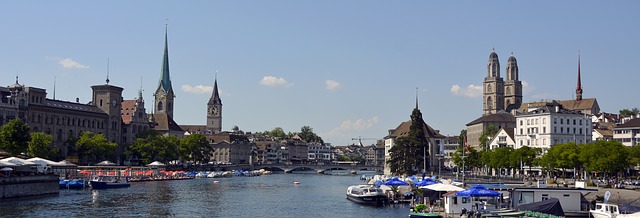By Tim Lambert
Early Switzerland
About 500 BC a Celtic people called the Helveti entered Switzerland from the west. However, by 58 BC the Romans ruled the area and they built a capital at Aventicum (Avenches). In the following centuries, Switzerland became thoroughly Romanized. The Romans built roads and other towns.
However, in 260 a tribe called the Alemani attacked the region. Switzerland never really recovered from the incursion and about 400 AD the Roman army withdrew altogether.
In the 5th century, AD people called the Alemans, Burgundians, and Lombards settled in Switzerland. However, in about 600 the Franks from France conquered them. In the 9th century under Charlemagne, the Franks ruled most of Europe.
However, their empire was split among his descendants, and by the 13th century, most of Switzerland was ruled by the Austrian Hapsburg family. Meanwhile, trade and commerce boomed in Switzerland in the 12th and 13th centuries, and new towns were founded.
In 1291 delegates from the cantons of Schwyz, Uri, and Unterwalden met at Rutli Meadow and allied against the Habsburgs. They formed the nucleus of modern Switzerland.
Switzerland went from strength to strength. In 1315 the Swiss defeated the army of Prince Leopold Hapsburg. Then in 1332, the canton of Luzern joined. The canton of Zurich followed in 1351. Later the cantons of Glarus, Zug, and Bern joined the Swiss Confederation. Furthermore, the Swiss defeated the Hapsburgs again at Sempach in 1386 and Nafels in 1388.
Renaissance Switzerland
In the 15th and early 16th centuries, Switzerland grew still larger and stronger. The cantons of Fribourg and Solothurn joined in 1481. Basel and Schaffhausen followed in 1501 and Appenzell joined in 1513. There were now 13 cantons making up Switzerland.
Meanwhile, Swiss soldiers became feared mercenaries in other parts of Europe. In 1506 Pope Julius II formed the Swiss Guard to be his bodyguard.
However, Switzerland suffered a defeat in 1515. In 1512 Swiss troops occupied Lombardy but in 1515 the French and Venetians defeated them at the battle of Marignano. Afterward, Switzerland began to adopt a policy of neutrality.
In the 16th century like the rest of Europe Switzerland was rocked by the Reformation. Urban parts of Switzerland embraced Protestantism but poor, rural areas remained Catholic. The leading figures in the Swiss Reformation were Ulrich Zwingli (1484-1531) in Zurich and Jean Calvin (1509-1564) in Geneva.
During the 17th century, Switzerland prospered. It stayed neutral in the Thirty Years War that engulfed Europe in the years 1618-1648 and in 1848 Austria formally recognized Swiss independence.
18th and 19th Century Switzerland
In the 18th century, economic growth in Switzerland continued. It was boosted by the arrival of Huguenots (French Protestants) fleeing religious persecution. Clock and watch-making flourished in 18th century Switzerland. So did the textile industry.
Then in 1798, Napoleon invaded Switzerland. He abolished the 13 cantons and replaced them with the Helvetic Republic. However, it was short-lived. The Swiss cantons were restored in 1803. (Although they were controlled by France until 1815).
In the early 19th century opinion between liberals and conservative Catholics in Switzerland became polarized. In 1845 seven Catholic cantons formed a union called the Sonderbund. Other Swiss demanded it be dissolved and in 1847 a short civil war was fought. It ended with the defeat of the Catholic cantons.
In the late 19th century the Swiss economy developed rapidly. Tourism to Switzerland grew. Switzerland was also known for its chemicals industry, its precision engineering, and food like chocolate and powdered milk.
20th Century Switzerland
During the First World War Switzerland remained neutral although many German-speaking Swiss supported Germany while many French-speaking Swiss supported the Allies.
Then in November 1918, a general strike was held in Switzerland. The Swiss army was sent to break the strike yet the workers did eventually win their demands. Proportional representation and a 48-hour working week were introduced.
In 1920 Switzerland joined the League of Nations and the 1920s were years of prosperity for the nation. However, like the rest of the world, Switzerland suffered from the depression of the early 1930s. However, in the late 1930s, the Swiss economy recovered as the world rearmed.
During the Second World War Switzerland remained neutral although Swiss banks accepted gold looted by the Nazis and Swiss industry helped to supply the German war machine. The post-war years were also prosperous for Switzerland but it was not until 1971 that women in Switzerland were allowed to vote! In 1993 Ruth Dreifuss became the first woman president of Switzerland.
21st Century Switzerland
In 2002 Switzerland joined the UN although it still has a policy of neutrality. Like the rest of Europe, Switzerland suffered a recession in 2009 but it recovered and today it is prosperous. In 2024 the population of Switzerland was 8.7 million.

Last Revised 2025